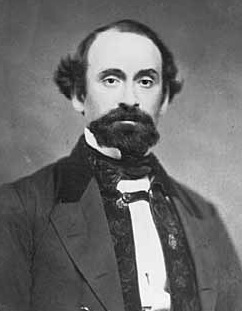John B. Sanborn facts for kids
Quick facts for kids
John Benjamin Sanborn
|
|
|---|---|

John B. Sanborn, c. 1860
|
|
| Born | December 6, 1826 Epsom, New Hampshire |
| Died | May 6, 1904 (aged 77) Saint Paul, Minnesota |
| Place of burial |
Oakland Cemetery, Saint Paul, Minnesota
|
| Allegiance | United States of America Union |
| Service/ |
United States Army Union Army |
| Years of service | 1861–1869 |
| Rank | |
| Unit | Army of the Mississippi |
| Commands held | Department of Southwestern Missouri Department of Arkansas |
| Battles/wars | American Civil War |
| Relations | John B. Sanborn, Jr. (son) Walter H. Sanborn (nephew) |
| Signature | |
John Benjamin Sanborn (December 5, 1826 – May 6, 1904) was a smart lawyer, a leader in politics, and a brave soldier from New Hampshire. He became a general in the Union Army during the American Civil War. After the war, he was an important member of a special group called the Indian Peace Commission. This group worked to make peace treaties with Native American tribes.
Contents
Early Life and Career
John B. Sanborn was born on a farm in Epsom, New Hampshire, on December 5, 1826. He was the youngest of five children. He went to school at Thetford Academy and the Pembroke Academy. For a short time in 1851–52, he attended Dartmouth College. He left college to study law with Asa Fowler in Concord.
In 1854, John passed his law exam. He then moved to St. Paul, Minnesota, in December of that year. In January 1855, he started a law firm with two other partners.
In March 1857, Sanborn married Catherine Hall. In 1859, he was chosen by the people to be a Republican representative in the Minnesota House of Representatives. In 1861, he was elected to the Minnesota State Senate. Sadly, his wife Catherine passed away in 1860.
Serving in the Civil War
Organizing Soldiers for the Union
In April 1861, John Sanborn was given an important job for the state. He became the Adjutant General. This meant he was in charge of getting three groups of volunteer soldiers ready. He had to make sure they had uniforms, weapons, and training for the new Union Army.
In December 1861, he became the colonel of the 4th Minnesota Infantry. His regiment was gathered at Fort Snelling between October and December. Sanborn and his men moved to St. Louis, Missouri, in April 1862.
Leading Troops in Battle
Sanborn led a group of soldiers, called a brigade, in the Army of the Mississippi. He fought in the Siege of Corinth, Mississippi, from May 18 to May 30, 1862. He also led his men in the Battle of Iuka on September 19 and the Second Battle of Corinth on October 3-4 of that year.
Sanborn's brigade fought in Ulysses S. Grant's Central Mississippi Campaign from November 1862 to January 1863. After that, they joined Grant's important Vicksburg Campaign. This included battles like the Battle of Port Gibson on May 1, the Battle of Raymond on May 12, and the Battle of Jackson on May 14.
He also took part in the Battle of Champion's Hill, the Battle of Big Black River, and the long Siege of Vicksburg from May 18 to July 4. During some of this time, he was in charge of an even larger group of soldiers, called a division. After Vicksburg surrendered, Sanborn's men stayed there to guard the area.
Becoming a General
On August 4, 1863, President Abraham Lincoln made Sanborn a brigadier general of volunteers. In October, the U.S. War Department put him in charge of the District of Southwestern Missouri. He played a key role in helping to defeat Confederate General Sterling Price during his Missouri Raid.
On February 10, 1865, President Lincoln gave Sanborn an honorary promotion. He was made a brevet major general of volunteers. This means he had the rank, but not always the pay or command of a full major general. The U.S. Senate confirmed this on February 20, 1865. Sanborn left the volunteer army on April 30, 1866.
Life After the War
Working for Peace
After the Civil War ended in 1865, Sanborn was sent to the Western frontier. His job was to help make peace with Native American tribes. In September, he, William Bent, and the famous explorer Kit Carson were chosen to negotiate peace treaties with several tribes.
In November 1865, Sanborn married for a second time to Anna Elmer Nixon. From February 1867 until 1869, Sanborn was a member of the Indian Peace Commission. This was a special group approved by the U.S. Congress. One of his big achievements was helping to negotiate the Medicine Lodge Treaty.
Sanborn was in charge of the District of the Upper Arkansas for a time. He left the army in 1869 and went back to Minnesota. He rejoined his law firm, Sanborn, French and Lund.
Return to Politics and Community
In 1872, he was elected to another term as a state representative. He stayed very involved in Minnesota politics and in groups for veterans, both in his state and across the country. He married a third time, to Rachel Rice.
In May 1903, Sanborn was chosen as the president of the Minnesota Historical Society. He passed away in St. Paul a year later.
His son, John B. Sanborn, Jr., also served in the Minnesota legislature. He later became a federal judge.
Images for kids
-
Bust of Sanborn by T.A.R. Kitson, Vicksburg National Military Park




